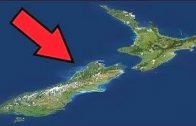Where Were The First And The Last Place Discovered On Earth?
There are a lot of places on Earth that we can be at or live on. But what was the first of these places discovered, and what was the last? Let’s explore these questions together!
13. In The Beginning
12. Africa
When it comes to the theories that guide our beliefs in terms of where life started, those of a scientific and archaeological nature seem to always point to one continent in particular as the “birthplace” of humanity. And that would be Africa. Which obviously is slightly ironic as the continent as a whole is viewed as “third-world” in many aspects because of the lack of technology within many of its countries and sometimes “primitive” ways of life. But that’s another topic entirely.
The exact origin point of life in Africa to start is a bit sketchy, but many people point to the area that is now Ethiopia as a likely candidate. And the year that it was “discovered” in certain ways is believed to be 195,000 B.C.
This is based not just on evidence of the area, but fossils of Homo Sapiens (meaning humans…)
11. Out Of Africa
Africa is a big place, but to get to where we are in the world today people needed to get out of it. So what was the first place they went to that wasn’t officially on the continent? We honestly don’t have to think too this, because technology wouldn’t have allowed them to go too far. Thus, the early Sapiens went from Africa to Arabia. Or as we would call it today, Yemen. Again, this is very logical as Yemen and Africa wouldn’t have been too difficult a gap to cross due to space. This happened about 125,000 years ago give or take.
Once that culture of people started to populate the area, they too began to expand, and that led them to the land we now know as Israel about 100,000 years ago give or take. Also around that time the early Arabians reached Oman, further expanding their reach in the area just out of Africa.
10. Asia’s Population Growth
As humanity began to expand, it continued to reach in all directions of the world. At this time, Africa had not been fully discovered, so progress was still being made on that front, such as reaching the areas that we now know as the Republic of Congo. But just as important, people started to reach out to the eastern parts of the world, including diving ever deeper into the continent we know as Asia.
For example, by about 70,000 years ago, humanity had reached India. Which if you recall is the second most populated nation in the world today, which means that from then to now it grew to support billions of people. And after 3000 years, the people went so far east that they reached the Philippines, which still stand as a mighty island nation. Which means that the desire to live in such places was born a very long time ago. Though still, exploration of the area was slow, as it took another 17,000 years for Taiwan..
9. Down Under
Instead of going east, let’s head south, shall we? About 48,000 years ago, Australia was first found by humans.
8. Island Hopping
Remember all the lands I noted that people missed on the way to Australia 48,000 years ago? Well to their credit, they were eventually found and inhabited. But not in the order you might expect. In fact, Japan was “found” first in around 47,000 BC, and then in 46,000 BC we found Laos and Indonesia.
7. Europe
6. The Americas
For the record, I’m speaking of what we now consider North and South America, not just the United States. But let me put you into a pop quiz situation. What was the first part of the Americas (either north or south) that had been discovered? It wasn’t the US, or Brazil, or even Mexico, it was actually Alaska.
5. Filling In The Map
By the time we get to 7500 BC, the map of the world is really starting to fill in. All of Europe as we know it right now has been discovered, Asia in its massive form is basically discovered too with some very small outliers. Such as Malta finally being discovered in 5200 BC.
By 2000 BC the Vikings had discovered Greenland (which they named thus because they wanted it to be a lure for people instead of going to more fertile lands…what jokers they were). And by 1000 BC the island nations of Samoa, Fiji and Vanatu were found floating around.
4. Madagascar
3. The Beginning of the End
If you wish to look for the “last truly big find” on the map, you have a few places to look. Such as 1300 AD when New Zealand was finally found by Polynesians.
Then, during the “European Age of Exploration”, a scattering of islands were “found” by them. Many were already populated though. Yet they did find some key places, including Bermuda (a wonderful vacation spot) in 1609.
Fast forward to 1770 and many other small remote islands had been found, including the Seychelles (another wonderful vacation spot).
2. Antarctica
1. More To Find?
Here’s the thing, the Earth isn’t just a planet, it’s a place that grows and evolves. Especially if you believe in Pangea and what happened to cause the 7 continents to be formed.
























